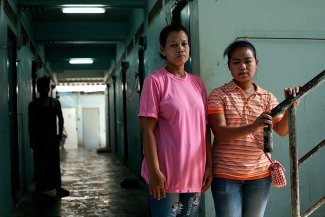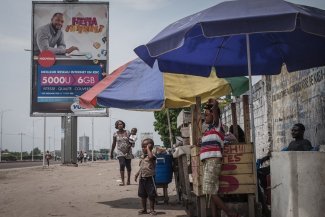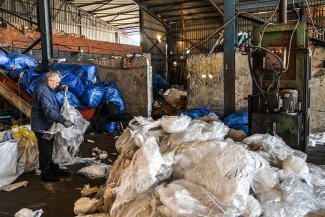In Rayong Bay, a few hours east of Bangkok, January is normally the season for cuttlefish and crabs. But this year the catch was different. Instead of fresh seafood, the fishermen returned to shore with ruined fishing gear. Everything was covered in black goo after a pipeline owned by Star Petroleum Refining Company (SPRC) and situated 20 kilometres off the coast leaked approximately 47,000 litres of crude oil into the Gulf of Thailand on 25 January.
Soon the eastern shore was swarming with hundreds of government workers in white jumpsuits cleaning up the oil washed ashore; while out at sea, marine ships sprayed dispersant chemicals into the ocean to push the oil down to the seafloor. The accident kept tourists away from once-busy beaches that had already suffered under the impact of Covid.

Tiraj Bunyong, son of Lamom, sails past BLCP Power, a coal-fired power plant in Map Ta Phut Industrial Estate on his way to a fishermen’s protest at sea on 28 February 2022. Tiraj spends every day on the water but barely catches any fish.
The exact size of the spill has been hard to establish. First it was reported that 400,000 litres of oil had leaked, but the number was revised several times, with the final figure eight times lower than the first one. This raised suspicion among locals, and environmental activists pointed out that the number did not seem to align with the amount of dispersant used.

A view of the Map Ta Phut Industrial Estate in Rayong province from the sea. It is the largest industrial park in Thailand and houses the country’s petrochemical industry.
The January spill was the second oil spill to take place in Rayong Bay. Ten days after this first 2013 spill, PTT Global Chemical – the oil company responsible – and government officials announced the oil had successfully been cleaned up. At first, the water quality seemed back to normal, but a few months later monsoon waves started washing tarballs onto the beaches. This continued for years.
After this first spill, fishermen also kept finding small cuttlefish bones, which indicated that the hatchlings had died abnormally early. Catches grew smaller and smaller, and fishermen sometimes caught deformed fish with white-spotted, blind eyes. The changes in the aquatic environment made veteran fisher Lamom Bunyong and other local fishermen suspect that something was not right.

On 28 February, around 100 fishing boats took part in a protest against the expansion of Map Ta Phut Industrial Estate in Rayong. In a pincer movement, an equal number of fishermen protested in front of the entrance to the industrial park on land. Having already experienced two successive oil spills and pollution problems, fisherfolk are concerned the expansion project will only add to their woes.
This morning, Tiraj Bunyong, Lamom’s son, steers his family’s fishing boat to join a protest at sea. He slows down the engine and turns the boat to face the shoreline, so that it shows the protest banners strung across the boat. Somewhere on land, Tiraj’s father is leading protesters to the gates fencing off the oil company that caused the recent oil spill.
The Bunyong family lives in Rayong’s Pak Nam subdistrict, only a few footsteps away from the beach and 15 kilometres from the Map Ta Phut Industrial Port, the biggest petrochemical industrial zone in Thailand. It is one of many industrial zones in this area known as the Eastern Economic Corridor, a special economic zone that allows extensive industrial development throughout Thailand’s eastern seaboard.

Hundreds of fishermen drove in a convoy to protest in front of Star Petroleum Refining Company (SPRC), a company majority-owned by Chevron, on 28 February 2022.
Only a few hours’ drive east of Bangkok, Rayong is known for its seafood and tourism. But since the early 1980s, an increasing number of industrial factories have been built along its coast. This has created pollution problems that have affected both farmers on land and fishermen at the sea.

Lamom Bunyong (centre, in a chequered shirt) tries to calm down angry fisherfolk during a February 2022 protest outside SPRC, the company responsible for the 2022 oil spill.
In 2009, the National Environment Board declared Rayong’s Map Ta Phut Industrial Estate a ‘pollution-controlled zone’ as a result of a 2009 legal challenge filed by Rayong locals over the Thai government’s issuance of permits to projects seen to be harmful to people and the environment without prior public hearings. This is required under the country’s constitution. The designation of the industrial park as a pollution-controlled zone was supposed to minimise the health impacts of industrial activities in the area. But so far, no measures have been implemented and there have been rumours that the pollution-controlled zone will be abolished.

A squid auction at Pak Nam harbour. The squids will be dehydrated and sold as dried squid, a local delicacy. But fishers will get less money for the squids than they used to. The thought of eating potentially contaminated seafood has worried many consumers and the price of the seafood has dropped as a result.
Since the first spill in 2013, industry and government representatives have reassured local fishermen that their livelihoods were safe, but locals could see with their own eyes that something was off.
Wanting to better understand the changes to the environment, a few locals started to collect video and photo evidence of irregular marine life and oil sightings. They gathered the footage in a group chat and sent it to a legal aid group in Bangkok in the hopes that it might one day serve as evidence in a court case.
In 2014, hundreds of local fishermen eventually filed a lawsuit against PTT Global Chemical and the Thai government over what they alleged was an improper and incomplete cleanup of the spill. It is the first legal case over an oil spill in Thailand and it is likely to set a precedent according to local environmental lawyers. The case is currently pending before the country’s Supreme Court.

Fishing boats return to shore at Pak Nam harbour after ten days of being at sea. Fishing boats are having to travel further and longer to catch enough fish to make the trip worthwhile.
“We have eyes all around,” says Lamom Bunyong, as he teaches a friend how to use a smartphone to send images of a thin film of oil floating on the sea surface. “We used to hold the actual fishing nets and now we are holding cameras.”

A photo album kept by Lamom Bunyong with photographs taken by local fishermen after the 2013 oil spill. Lab tests on fish blood samples have revealed the presence of polycyclic aromatic hydrocarbon (PAH), a component of crude oil that can accumulate in marine animal tissue and cause DNA mutations.
Not only in Rayong but all across Thailand, local communities have turned to citizen science as a tool to understand and document the impact of development projects and pollution disasters in their hometowns.

Lamom Bunyong stands on a beach at Pak Nam with Ziplock bags of oil he collected from the beach during the 2013 oil spill. He has taken these bags into courtrooms to demonstrate the physical evidence of the spill. The oil spills in 2013 and 2022 are marked by several parallels, from the uncertainty around the amount of oil leaked into the sea, to the authorities’ refusal to admit to their continuing impact on marine life.
“First I didn’t care about the spill, but later on I realised that I’m also affected,” Nawarat Thoopbusha, a fishing gear shop owner says, pointing out that the oil spill has impacted many sectors in the province. “It affects the fishermen, the seafood restaurants and processors, the hotel owners and so on. Not to mention consumers, as seafood prices are rising so much because the fishing boats have to travel further,” she tells Equal Times.

A local repairs a fishing net on a beach close to the site of the 2022 oil spill. Those hardest hit by the pollution from the surrounding industrial parks are the small-scale local fishermen who fish the surrounding waters close to shore in their smaller boats.
After the January 2022 oil spill, SPRC set up a complaint centre at a local hotel where affected locals could register for compensation. A month later, the company closed the registration process, having received 13,000 complaints from the local community. Locals continue to organise protests, hold public panels and gather evidence with the hopes of filing a lawsuit for compensation and restoration of the environment.
“It started with only a few community leaders, but now more people are seeing that the evidence can help them claim their rights,” says Weerawat Ob-o, a lawyer with the Community Resources Centre, a legal aid group that has been working with the Rayong fishermen since the first spill back in 2013. “Some believe the impact [of the oil spill] is gone. But with the evidence people are collecting, they are becoming aware that the problem isn’t over.”















